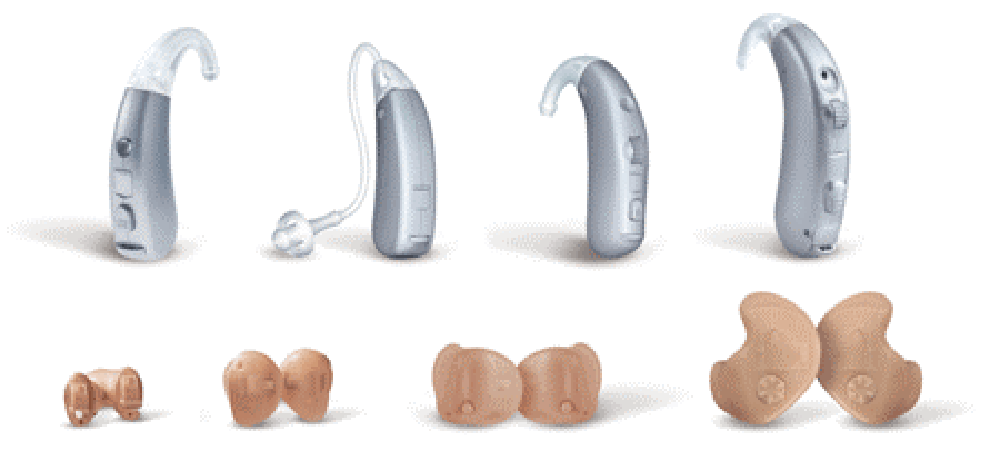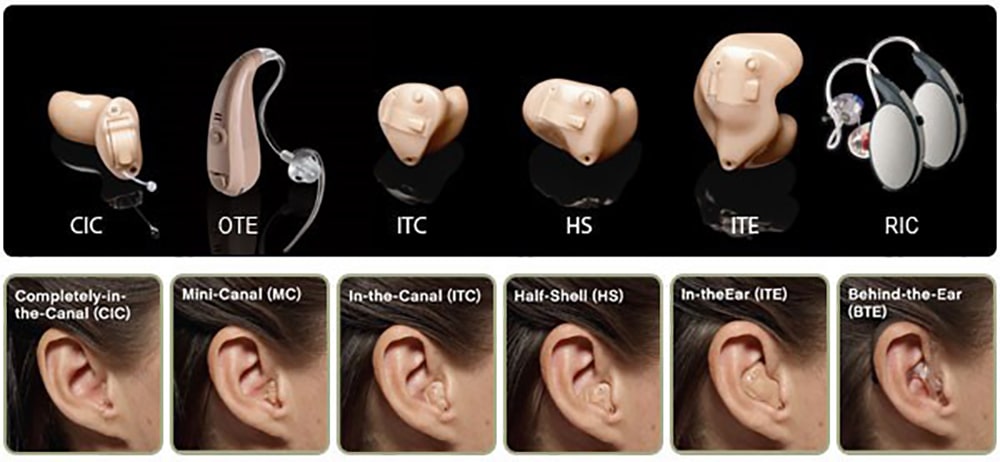Hearing Aid

A hearing aid is a small electronic device that you wear in or behind your ear. It makes some sounds louder so that a person with hearing loss can listen, communicate, and participate more fully in daily activities. A hearing aid can help people hear more in both quiet and noisy situations. However, only about one out of five people who would benefit from a hearing aid actually uses one.
A hearing aid has three basic parts: a microphone, amplifier, and speaker. The hearing aid receives sound through a microphone, which converts the sound waves to electrical signals and sends them to an amplifier. The amplifier increases the power of the signals and then sends them to the ear through a speaker.
Hearing aids are primarily useful in improving the hearing and speech comprehension of people who have hearing loss that results from damage to the small sensory cells in the inner ear, called hair cells. This type of hearing loss is called sensorineural hearing loss. The damage can occur as a result of disease, aging, or injury from noise or certain medicines.
A hearing aid magnifies sound vibrations entering the ear. Surviving hair cells detect the larger vibrations and convert them into neural signals that are passed along to the brain. The greater the damage to a person’s hair cells, the more severe the hearing loss, and the greater the hearing aid amplification needed to make up the difference. However, there are practical limits to the amount of amplification a hearing aid can provide. In addition, if the inner ear is too damaged, even large vibrations will not be converted into neural signals. In this situation, a hearing aid would be ineffective.
If you think you might have hearing loss and could benefit from a hearing aid, visit your otolaryngologist or audiologist. An otolaryngologist is a physician who specializes in ear, nose, and throat disorders and will investigate the cause of the hearing loss. An audiologist is a hearing health professional who identifies and measures hearing loss and will perform a hearing test to assess the type and degree of loss.

Behind-the-Ear (BTE) - Sits behind your ear and is connected to an ear mold placed inside your ear via tubing. BTE devices are fastened on the ear with an ear hook and the ear molds are custom made to fit the user's ear.
In the Ear (ITE) - These are placed in the ear of the wearer.
In the Canal (ITC) and Completely in the Canal (CIC) - With ITCs and CICs, the whole hearing aid is placed inside the canal. ITCs are often larger than CIC devices. CICs are extremely tiny in size and are almost invisible.
Body-worn hearing aids - These aids use an external box worn by the user. The user wears an ear piece which is attached to the box by a wire.
The type of hearing aid devices recommended for users will greatly depend on the nature and extent of hearing loss and the size and shape of the outer ear and canal as some conditions (e.g ear drainage) may prevent a person from wearing hearing aids that block the ear or canal.
Aesthetic considerations play a large role for some wearers who may prefer wearing nearly invisible aids, while others prefer an aid that although visible blends with their skin tone. Small hearing aids (ITCs or CICs) also have tiny batteries and those with limited dexterity or sight problems may find these difficult to operate.
There are many factors that need to be considered when estimating the price of the hearing aid: What type of aid is it? What accessories does it have? Is it digital or analogue? Is it programmable? What are the capabilities and product features?
One hearing aid can cost Rs. 8000 to Rs. , 3,00,000 for models with the most cutting-edge technology.
Hearing aids work differently depending on the electronics used. The two main types of electronics are analog and digital.
Analog aids convert sound waves into electrical signals, which are amplified. Analog/adjustable hearing aids are custom built to meet the needs of each user. The aid is programmed by the manufacturer according to the specifications recommended by your audiologist. Analog/programmable hearing aids have more than one program or setting. An audiologist can program the aid using a computer, and the user can change the program for different listening environments—from a small, quiet room to a crowded restaurant to large, open areas, such as a theater or stadium. Analog/programmable circuitry can be used in all types of hearing aids. Analog aids usually are less expensive than digital aids.
Digital aids convert sound waves into numerical codes, similar to the binary code of a computer, before amplifying them. Because the code also includes information about a sound’s pitch or loudness, the aid can be specially programmed to amplify some frequencies more than others. Digital circuitry gives an audiologist more flexibility in adjusting the aid to a user’s needs and to certain listening environments. These aids also can be programmed to focus on sounds coming from a specific direction. Digital circuitry can be used in all types of hearing aids.
Hearing aids take time and patience to use successfully. Wearing your aids regularly will help you adjust to them.
Become familiar with your hearing aid’s features. With your audiologist present, practice putting in and taking out the aid, cleaning it, identifying right and left aids, and replacing the batteries. Ask how to test it in listening environments where you have problems with hearing. Learn to adjust the aid’s volume and to program it for sounds that are too loud or too soft. Work with your audiologist until you are comfortable and satisfied.
You may experience some of the following problems as you adjust to wearing your new aid.
- My hearing aid feels uncomfortable. Some individuals may find a hearing aid to be slightly uncomfortable at first. Ask your audiologist how long you should wear your hearing aid while you are adjusting to it.
- My voice sounds too loud. The “plugged-up” sensation that causes a hearing aid user’s voice to
sound louder inside the head is called the occlusion effect, and it is very common for new hearing aid users. Check with your audiologist to see if a correction is possible. Most individuals get used to this effect over time. - I get feedback from my hearing aid. A whistling sound can be caused by a hearing aid that does not fit or work well or is clogged by earwax or fluid. See your audiologist for adjustments.
- I hear background noise. A hearing aid does not completely separate the sounds you want to hear from the ones you do not want to hear. Sometimes, however, the hearing aid may need to be adjusted. Talk with your audiologist.
- I hear a buzzing sound when I use my cell phone. Some people who wear hearing aids or have implanted hearing devices experience problems with the radio frequency interference caused by digital cell phones. Both hearing aids and cell phones are improving, however, so these problems are occurring less often. When you are being fitted for a new hearing aid, take your cell phone with you to see if it will work well with the aid.
Proper maintenance and care will extend the life of your hearing aid. Make it a habit to:
- Keep hearing aids away from heat and moisture.
- Clean hearing aids as instructed. Earwax and ear drainage can damage a hearing aid.
- Avoid using hairspray or other hair care products while wearing hearing aids.
- Turn off hearing aids when they are not in use.
- Replace dead batteries immediately.
- Keep replacement batteries and small aids away from children and pets.
- Check Battery - turn the hearing aid on full and cup in palm of hand to produce feedback or squeal. Check tiny holes (sound channels) on canal tip to be sure they are not plugged with wax or dry skin. Gently clean with the brush or wax loop. Replace battery if no feedback present. Battery should last 10 - 14 days.
- Check ear canal portion of the aid for wax. Remove it gently if present.
- Check for dirt on volume control or microphone. Clean gently with brush. DO NOT WET.
- If user is unable to manage aid, nursing staff, a family member or a caregiver should periodically check to make certain aid is turned on and inserted correctly.
- When aid is not in use, make certain aid is off and remove the battery as it may leak and corrode.
- Dispose of expired batteries carefully and properly. They are toxic if swallowed.
